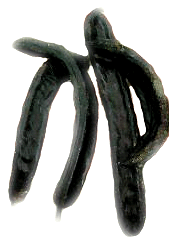|
|
|
|
 Carob, Ceratonia siliqua Locust Bean, St. Johns Bread Carob pods and beans have been used for food for over 5000 years. From an evergreen tree that is often used as an ornamental outside its native environment of the Middle east. The trees fruit consists of large pods that reach 8 inches in length, and ripen from green to a rich brown. The pods contain a row of very hard seeds which are not useful for eating purposes. These seeds are however very consistent in size and weight, so much so that the Arab Merchants used them for weighting value able merchandise like precious medals and jewels. The sweet pods are chewed by children in the Middle
East, and used as animal fodder. In the modern kitchen carob as been
incorporated as a replacement for coffee or chocolate when a flavoring is
needed and caffeine is an issue. Carob contains no caffeine or
oxalic acid and half the fat of cocoa. The tough chewing pods can sometimes be purchased from specialty suppliers and are very tasty with a sugar content of thirty to forty percent. Apart from being chewed as a sweetmeat, carob pods are processed to a cocoa -like flour which is added to cold or heated milk for drinking. It has been combined with wheat flour in making bread or pancakes. A flour made by beating the seeded pods is high in fiber and has been utilized in breakfast foods. The finer flour is also made into confections, especially candy bars. The pods, coarsely ground and boiled in water yield a thick, honey-like sirup, or molasses. The seeds yield a tragacanth-like gum (manogalactan), called in the trade "Tragasol", which is an important commercial stabilizer and thickener in bakery goods, ice cream, salad dressings, sauces, cheese, salami, bologna, canned meats and fish, jelly, mustard, and other food products. The seed residue after gum extraction can be made into a starch- and sugar-free flour of 60% protein content for diabetics. In Germany, the roasted seeds have served as a substitute for coffee. In Spain, they have been mixed with coffee.
|

